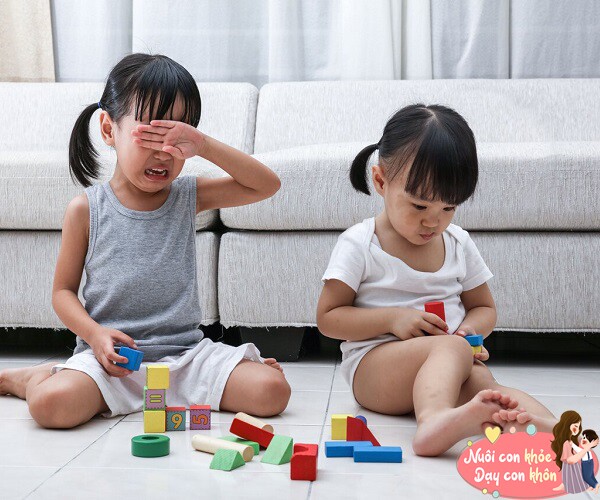Helping children understand and manage these emotions helps them overcome challenges, build resilience, and develop strength for the future.
Children often struggle to express and understand complex emotions as well as adults. Therefore, the first step is to help children recognize and understand the feeling of loss.

Illustration.
Accepting loss is a process and not always easy. Parents can explain to children that feeling sad, angry, or even guilty is a natural response to experiencing loss.
Teach children that allowing themselves to feel these emotions is an important part of healing. Parents can use stories or examples from life to illustrate this.
By helping children recognize, express, and accept their emotions, parents not only help them overcome the pain of loss but also equip them with the necessary life skills to face future challenges. This contributes to their growth and the formation of important human values in life.
 Psychologist Quang Thi Mong Chi.
Psychologist Quang Thi Mong Chi.

As children grow up, they will face various challenges, one of which is learning how to face loss (losing a beloved toy or a family member passing away). How can we explain the concept of loss to children of different ages?
Explaining the concept of loss to children should be age-appropriate and consider their level of understanding and emotions. Here are some approaches to explaining loss to children of different ages:
For preschoolers (3-5 years old): Children at this age tend to take things literally and may not yet grasp the concept of permanence. Keep the explanation simple and gentle.
For example, if a child loses a favorite toy, parents can explain that: “Your toy has gone far and will not come back. But we can remember it together and find joy in other toys.”
In the case of losing a family member, parents can say: “He/she has gone to a far place, and we can’t meet them, but they will always live in our hearts.”
Children may need time to understand and may ask multiple times. Therefore, parents need to be patient and always listen and respond to their questions.
For elementary school children (6-9 years old): Children at this age begin to understand the concept of permanence better and may feel loss more deeply.
Parents can say to the child: “Sometimes, the things we love may no longer be with us, and this makes us sad. But we can always remember the beautiful moments we had with them.”
Or, when a family member passes away, parents can explain: “When someone is no longer with us, it means they have finished their journey in this world. Although we can’t meet them again, the love and memories of them will always be in our hearts.” Elementary school children often have deeper questions, so parents should be prepared to answer and help them talk about their emotions.
For early teenagers (10-15 years old): Teenagers at this age have a deeper understanding of death. They may need more space to express their emotions and thoughts privately.
When a child loses an object, parents should encourage them to understand that: “Losing something can make us sad, but what’s important is the value it brought and how it helped us create beautiful memories.”
When a family member passes away, parents can say: “Losing a loved one is a part of life. It’s something that happens to everyone, and we will always have the memories and lessons they left us. We can remember them by living positively and lovingly.” Listen to and respect the way the teenager wants to honor or share their emotions.
For older teenagers (above 15 years old), they may have a deeper understanding and sometimes a need for self-exploration of the meaning of loss. Parents should create a space for them to freely express their emotions and thoughts. For example, in the case of losing an object, parents should encourage them to reflect on the actual value of the item and realize that loss is a natural part of life.
In the case of losing a family member, parents can explain the biological or philosophical aspects of life, if the teenager is interested, such as: “Loss is something we all have to face, and that’s why we should cherish the present moments. Everyone who comes into our lives leaves an impression, and the love for them doesn’t disappear.”
At the same time, parents should encourage teenagers to share their emotions, participate in memorial activities, or record beautiful memories.
Explaining the concept of loss to children requires patience and sensitivity from adults, helping children develop a positive and healthy attitude when facing losses in life.

How can loss affect children’s psychological development in the short and long term?
Loss can profoundly impact children’s psychological development, both in the short and long term, depending on their age, the degree of attachment to the lost person or object, and the support they receive from their family and surroundings.
In the short term, children may experience various psychological and emotional reactions. Loss can cause immediate feelings of sadness and grief. Younger children may not fully understand what loss means but can feel anxious and confused, especially if it is their first experience with it. Children may become clingy, cry more, or display negative behaviors, especially when losing a familiar person.
Some children may become quiet and withdraw from friends or favorite activities. Additionally, loss can cause a loss of interest in learning and impact their ability to concentrate. Children may become distracted, struggle to complete their homework, and experience a decline in academic performance. Some children may have nightmares, difficulty sleeping, or frequent awakenings, especially if the loss involves the death of a loved one. Dreams or worries may reflect the child’s sense of insecurity.
If not supported appropriately, loss can have long-lasting effects on children’s psychological development. In particular, the emergence of prolonged feelings of insecurity or anxiety, especially when the loss occurs suddenly or is not adequately explained.
This can lead to anxiety about losing other loved ones or fears regarding separation. Consequently, loss can influence the ability to develop healthy relationships later in life. Children may become hesitant to trust and attach to others due to the fear of loss, creating difficulties in forming emotional connections, especially during adulthood.
For some children, losing a parent or primary caregiver can result in feelings of low self-worth or a sense of unworthiness of receiving love or protection. Some children may develop psychological disorders, such as depression or anxiety, or adopt unhealthy coping mechanisms, such as withdrawal, self-isolation, or a lack of emotional regulation.

How can parents create a safe space for children to express their emotions?
To create a safe space for children to express their emotions, parents need to demonstrate active listening, understanding, and non-judgment. Here are some ways to help children feel comfortable sharing their emotions:
When a child wants to talk about their emotions, parents should pause and give them their undivided attention, conveyed through eye contact, body language, and an undistracted attitude. Attentive listening will help the child feel that their emotions are valued.
At the same time, parents should use open-ended questions like “How do you feel about this?” or “Can you tell me more about that?” to encourage deeper sharing. When a child expresses their emotions, parents should respond by showing understanding, such as: “I see that you’re sad, and that’s completely understandable” or “I get it; that situation must be worrying for you.” This helps the child feel empathized with and understand that their emotions are valid. Avoid dismissing the child’s emotions with phrases like “It’s okay, don’t be sad” as it may discourage them from expressing emotions in the future.
Even if the child’s emotions are intense or uncomfortable, parents should refrain from judging or scolding. Instead of saying, “It’s gone, don’t be sad,” try: “I see that you’re angry; I understand that this situation is frustrating for you.”
Parents can also teach children to recognize and name their emotions, such as “sad,” “happy,” “scared,” or “angry.” This helps children understand their emotions and express them effectively. Visual aids, such as emotion charts or storybooks, can be used to help children learn to identify and label their emotions. At the same time, parents can help children understand that all emotions are natural and acceptable, but there are appropriate and inappropriate ways to express them. For example, if a child is angry, parents can help them choose a different way to express it instead of yelling or hitting others.
Sometimes, children need time alone to think and feel. Parents can provide a private space, such as a quiet corner in the house where the child can relax or think without interruptions, and allow them to choose when and how to express their emotions, rather than forcing them to talk immediately. Moreover, children often learn how to cope with emotions by observing their parents. When parents model calm and positive emotional expressions, children are more likely to follow suit. For instance, when parents feel stressed, they can say: “I’m feeling stressed, and I need some time to calm down.”
Additionally, parents can encourage children to draw, keep a journal, or tell their stories as a safe way to express their emotions. These activities not only help children feel better but also provide parents with insights into their emotions and thoughts.
By creating a safe space for children to express their emotions, parents not only help them understand and manage their emotions but also build trust and strengthen the parent-child bond, contributing to the development of a healthy psychological foundation and social confidence in the future.

What learning opportunities about life and existence can loss offer to children, and how can we seize these opportunities?
Loss, whether it’s the passing of a loved one, a pet, or a valuable possession, can present valuable learning opportunities for children to gain profound insights into life and existence.
Loss helps children understand that life has a beginning and an end. This is a chance to explain the life cycle, helping children realize that all living beings have a finite lifespan and go through the stages of birth, growth, and death. Therefore, loss is an inevitable part of life, and we need to learn to adapt to it.
In this context, parents can guide children to focus on what remains, such as the love from those around them, and encourage them to seek new joys. Emphasize that instead of clinging to what’s gone, we can cherish and appreciate what we have in the present.
Experiencing loss teaches children to empathize with others’ pain, fostering their ability to be compassionate and sensitive. Here, parents can encourage children to share their emotions and ask questions, creating opportunities for them to show concern for others who are also grieving. Parents can write a comforting letter or prepare a small gift with the child to offer to someone who is sad, encouraging them to practice empathy and sharing.
Children can also learn that even if a person or thing is no longer physically present, the memories and emotions remain in the heart. By encouraging children to create mementos, such as a photo album, a drawing, or a story about the deceased person or object, parents reinforce this understanding.
Tell children that the way we remember and cherish memories is how we keep our loved ones close. Loss helps children learn to face and gradually recover from sadness. It presents an opportunity for children to develop patience and emotional regulation skills.
Parents can teach children basic emotional regulation techniques, such as deep breathing when feeling sad or drawing and journaling to express their grief. Encourage children to openly share their emotions and emphasize that feelings of sadness, anger, or longing are natural and manageable.
While loss can be a significant challenge, it is also an opportunity for children to build resilience and find strength in difficult times. Parents can remind children of past difficulties they have overcome and encourage them to believe in their ability to cope with the current loss. Sharing positive stories about overcoming hardships and instilling confidence in their ability to face challenges can be beneficial.
In summary, when children experience loss, it is not just a source of pain but also an opportunity for growth and maturity. With support and guidance from parents, loss can become a profound lesson that helps children gain a deeper understanding of life, love, and the value of what surrounds them.
The Boy Who Took His Friend’s Belongings: A Mother’s Wise and Dignified Response
Teaching your children to behave appropriately and not cause a ruckus in public is an important task for parents. It is essential to instill these values early on to ensure your little ones grow up to be respectful and well-mannered individuals. This process begins at home, with parents modeling good behavior and setting clear expectations for their children’s conduct. By providing a solid foundation of discipline and guidance, parents can help their children navigate social situations confidently and politely.






































